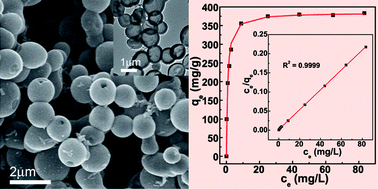Synthesis of polyaniline micro/nanospheres by a copper(ii)-catalyzed self-assembly method with superior adsorption capacity of organic dye from aqueous solution†
Abstract
Hollow and core-shell

* Corresponding authors
a
Key Laboratory of Materials Physics and Anhui Key Laboratory of Nanomaterials and Nanostructures, Institute of Solid State Physics, Hefei Institutes of Physical Science, Chinese Academy of Sciences, P.O. Box 1129, Hefei, P. R. China
E-mail:
gtfei@issp.ac.cn
Fax: +86-551-5591434
Tel: +86-551-5591453
Hollow and core-shell

 Please wait while we load your content...
Something went wrong. Try again?
Please wait while we load your content...
Something went wrong. Try again?
X. Guo, G. T. Fei, H. Su and L. D. Zhang, J. Mater. Chem., 2011, 21, 8618 DOI: 10.1039/C0JM04489J
To request permission to reproduce material from this article, please go to the Copyright Clearance Center request page.
If you are an author contributing to an RSC publication, you do not need to request permission provided correct acknowledgement is given.
If you are the author of this article, you do not need to request permission to reproduce figures and diagrams provided correct acknowledgement is given. If you want to reproduce the whole article in a third-party publication (excluding your thesis/dissertation for which permission is not required) please go to the Copyright Clearance Center request page.
Read more about how to correctly acknowledge RSC content.
 Fetching data from CrossRef.
Fetching data from CrossRef.
This may take some time to load.
Loading related content
